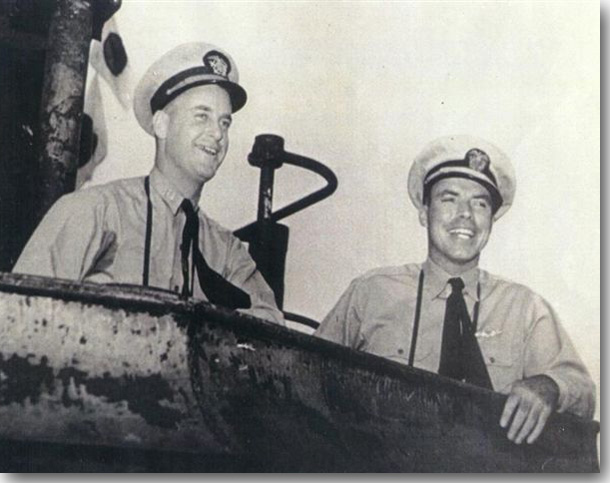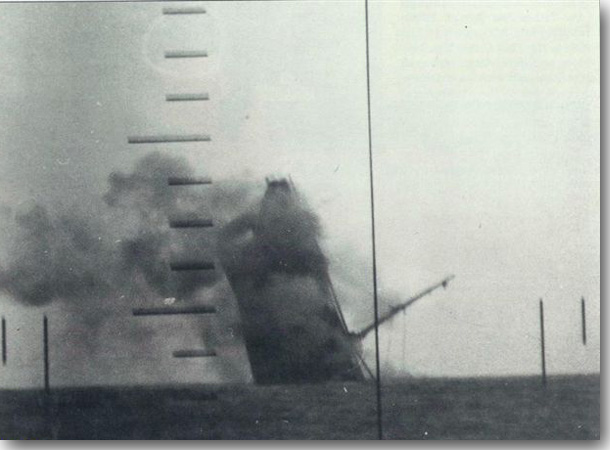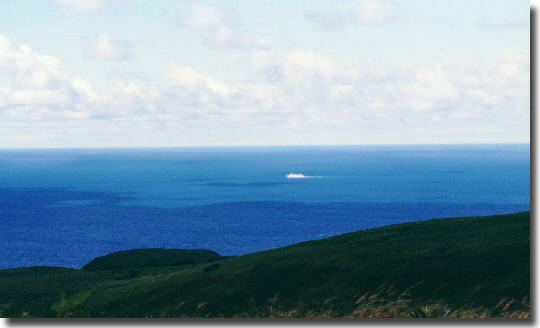Introduction.
The US submarine Wahoo was amongst the top performing boats of WW2. In October 1943, in the Sea of Japan she went missing, to be declared lost with her 80 crew on the 9th. of November that year.

USS Wahoo
Length: 311 feet
Speed: Surfaced: 20.25 knots; submerged: 8.75 knots
Armament: One 3-inch cannon, two .30-caliber machine guns, two .50-caliber machine guns, 10 21-inch torpedo tubes
Crew: 79
Class: Gato
It is interesting to note that it is usual when attacking a target for the submarine CO to man the periscope, in Wahoo, whilst Richard O'Kane was her executive officer in 1942, he always manned the periscope during an attacking run.

O'Kane and her CO Morton on Wahoo's bridge
The US Wahoo Group takes as its task to seek out the whereabouts of five lost WW2 US submarines, in June of 2006, USS Lagarto ( SS-371 ) was identified in the Gulf of Siam, now the wreck of USS Wahoo is found by a Russian Dive Team at the end of July 2006.

The sinking of Nitu Maru by Wahoo
Russians find wreck of Wahoo.
In July 2006, the Russian sailboat Iskra looking in the Sea of Japan, for the last Russian submarine to go missing in WW2, has stumbled upon the wreck of missing US Submarine, the Gato Class USS Wahoo, lost back on the 11th. of October 1943, and listed as missing with all 80 crew members on the 9th. of November that year.
See http://www.warfish.com/scrap-EP.html for pictures of Wahoo on the bottom.
USS Bowfin Museum Press Release August 2006.
The Search for USS Wahoo (SS-238)
Energy Company confirms research team’s position.
Russian Divers prove site as submarine.
The search project for the World War II United States submarine USS Wahoo (SS–238), taken to a new level with the assistance of major energy contractors and Russian Authorities, has confirmed what the USS Wahoo Project Group believes may be the final resting place of America’s most famous WWII submarine.
( Wahoo actually comes in third, amongst the USN submarines for top tonnages sunk in WW2, note by Mackenzie Gregory. )
The Project Group was given a substantial lift when Sakhalin Energy Investment Company Ltd. provided immense support in the form of offshore electronic surveys of sites previously indicated to the Russian authorities by the USS Wahoo Project Group, headed by the MacKinnon Organization (Japan) and the Ocean Wilderness Group, (Australia). The surveys confirm a side scan anomaly, which may possibly be the submarine USS Wahoo. The energy company, aware of the historic and humanitarian operation, selflessly offered its support, which coincided with its own offshore surveys.
A sub-sea survey conducted by Russian divers out of Vladivostok, utilizing the Project Group’s information, confirmed the findings as a submarine at the end of July.
The USS Wahoo Project Group received U S Navy approval for their South China Sea Project, the search for five lost US WW II submarines and several other vessels in 2003 after their approach to the US Secretary of the Navy, following many years of development. The Project Group has received continual support and assistance from Russian and Japanese authorities, sponsors, veterans and researchers form several countries. The USS Bowfin Submarine Museum, the project’s scrutineers, research custodians and project curators, will be the official recipient of the project on behalf of those who were lost, their families, and their comrades. The Museum will work closely with the USS Wahoo Project Group and US Navy, Russian, and Japanese authorities in the correct approach management of the confirmation identification project. Specialist Archaeologists and Anthropologists have been appointed to oversee the identification project, and work with Ocean Wilderness Group divers to document the site.
The project, which has been an epic of research and beauracratic negotiation, has brought together several nations, individuals, private organizations and companies in support of veterans and families of the lost from previously opposing nations. The generation of goodwill and the prospect for closure, historic documentation of the site and the commemoration of the brave by the United States, Japanese and Russian governments is remarkable. The support of the Russian Federation Foreign Affairs Department, and the assistance provided to the Project Group by the Russian Federation Embassy to Australia has been exceptional.
Managed by Bryan MacKinnon, grandnephew of Wahoo Commander Dudley “Mush” Morton, the Project Group, now preparing a complete, non- intrusive sub-sea survey, has a thorough understanding of their responsibilities with regard to the USS Wahoo site and other sites. The group has no intention of either releasing the location of, or interfering in any way, with the site. Their primary aim is to verify, document, and to provide record of the USS Wahoo and her resting place as the tomb of eighty brave souls, entrusting all gathered materials to the USS BoIwfin Submarine Museum and the appropriate authorities for historic and commemorative purposes, and to close another mystery in the chapter of events known as World War II.
This effort follows up the June 2006 final identification of the USS Lagarto in the Gulf of Siam.

Sooya Strait, The scene of Wahoo's demise
Conclusion.
Discovery of lost WW2 merchant, surface warships, and submarines, sometimes is a matter of years of painstaking research, the use of modern diving techniques, and intrepid dive teams, and sometimes a matter of pure luck.
In this case, finding the wreck of Wahoo, seems a case of the latter, whilst searching for the last WW2 Russian submarine to go missing, they turn up the wreck of the USS Wahoo. One more example of a secret locked away for the past 63 years, at last solved, so that the relatives of all of Wahoo's crew may now know the final resting place of their loved ones who lay in peace at a depth of about 200 feet in the Sea of Japan.

U.S.S. Wahoo pictured in July 1943 off Mare Island Navy Yard. Commanded by Dudley "Mush" Morton,
Wahoo was one of the most successful American submarines of World War II.
Four months after this picture was taken she was lost with all hands while attempting to exit the Sea of Japan
after sinking four ships for a total of 13,000 tons. Her wartime total was 60,038 tons.
Navy says wreck found off Japan is legendary sub USS Wahoo
Read more here.
From Commander, U.S. Pacific Fleet Public Affairs
PEARL HARBOR, Hawaii (Oct 31, 2006) – For more than six decades her whereabouts have remained a mystery; her story one of submarine legend – her crew on “Eternal Patrol.”
Yet, after an extensive review of evidence, the last chapters are being written as the Commander, U.S. Pacific Fleet declared today that the sunken submarine recently discovered by divers in the Western Pacific is, indeed, the World War II submarine USS Wahoo (SS 238).
"After reviewing the records and information, we are certain USS Wahoo has been located," said Adm. Gary Roughead, the U.S. Pacific Fleet commander. “We are grateful for the support of the USS Bowfin Submarine Museum and Park and appreciate greatly the underwater video footage of the submarine provided by our Russian navy colleagues, which allowed us to make this determination. This brings closure to the families of the men of Wahoo - one of the greatest fighting submarines in the history of the U.S. Navy."
In July, the Russian dive team “Iskra” photographed wreckage lying in about 213 feet (65 meters) of water in the La Perouse (Soya) Strait between the Japanese island of Hokkaido and the Russian island of Sakhalin. The divers were working with The Wahoo Project Group, an international team of experts coordinated by Bryan MacKinnon, a relative of Wahoo’s famed skipper, Cmdr. Dudley W. “Mush” Morton.
“I am very pleased to be part of an effort where old adversaries have joined together as friends to find the Wahoo,” said MacKinnon.
Wahoo was last heard from Sept. 13, 1943, as the Gato-class submarine departed the island of Midway en route to the “dangerous, yet important,” Sea of Japan. Under strict radio silence, Morton and his crew proceeded as ordered. Radio contact was expected to be regained with Midway in late October upon Wahoo’s departure from the Sea of Japan through the Kurile Island chain. No such contact was made. Following an aerial search of the area, Wahoo was officially reported missing Nov. 9, 1943.
At the time, the loss of Wahoo was believed due to mines or a faulty torpedo. But Japanese reports later stated that one of its planes had spotted an American submarine in the La Perouse Strait on Oct. 11, 1943. These reports indicate a multi-hour combined sea and air attack involving depth charges and aerial bombs finally sunk Wahoo.
Japan Maritime Self Defense Force retired Vice Adm. Kazuo Ueda assisted the group with providing historical records from the Imperial Japanese Navy that identified the location where Wahoo was sunk.
“We, the families of Wahoo, recognize the historical scholarship and support provided by the Japan Maritime Self Defense Force. We would also like to send our thanks to the U.S. Navy for their diligence in finding and identifying the USS Wahoo,” said Doug Morton, son of Dudley Walker Morton.
“The Morton family is thrilled that there will be closure to the loss of our father,” added Morton, who also spoke on behalf of his sister, Edwina Thirsher and her family. “The loss of a famous submariner who was loved by his family and crew has been very difficult.”
During Wahoo’s rare foray in the Sea of Japan, Morton reportedly sunk at least four Japanese ships. For the patrol, Morton was posthumously awarded the Navy Cross – his fourth.
Morton is credited with sinking 19 ships totaling nearly 55,000 tons during his four patrols in command of USS Wahoo; his total was second only to his own executive officer, Richard H. O’Kane. Retired Rear Adm. O’Kane went on to command USS Tang (SS 306) and to receive the Medal of Honor.
Noted naval historian Theodore Roscoe described Morton as “an undersea ace” in his book “Submarine Operations in World War II.”
“Few skippers equaled Morton’s initiative, and none had a larger reserve of nerve,” Roscoe wrote. “Combining capability with dynamic aggressiveness, Morton feared nothing on or under the sea.”
The discovery of Wahoo is the culmination of more than a decade of work by an international team dedicated to finding the ill-fated submarine. In 2004, electronic surveys sponsored by a major international energy company (The Sakhalin Energy Investment Corporation) identified the likely site.
The Bowfin Museum in Hawaii worked with the team as an independent “scrutineer” to ensure the project was done correctly and will serve as a central repository for all the Wahoo Project’s findings, according to museum executive director, submariner, and retired Navy Capt. Jerry Hofwolt.
“This is the right thing to do for the families,” Hofwolt said. “We want to be able to tell people that this is where your loved ones are and to be a clearinghouse for all of the information about this and other lost submarines.”
Hofwolt said the museum is making plans to host a memorial ceremony to honor the crewmembers, most likely in October 2007.
Officials with the Pacific Fleet Submarine Force reviewed analysis and photos provided by the Bowfin Museum and agreed the wreck is USS Wahoo. The wreck had several characteristics consistent with USS Wahoo, and the submarine was found very near those reported in Imperial Japanese Navy records. Photographs are available at www.warfish.com and www.oneternalpatrol.com. General information about the USS Wahoo Project is available at www.usswahoo.org.
Wahoo is believed to be near the site of the Russian submarine L-19, possibly sunk by mines in late August 1945 after Japan had surrendered. Based on the information made available to them by The Wahoo Project Group, the Russian team wished to confirm the site was Wahoo and not the L-19. According to The Wahoo Project Group Web site, the group has offered continued assistance to the Russian government in finding that submarine as well.
In addition to the ceremony to be held in Pearl Harbor, U.S. Navy officials are planning an at-sea, wreath-laying service sometime next year to pay tribute to USS Wahoo. If it can be arranged, a combined service with the Russians and Japanese to honor USS Wahoo and the Russian submarine L-19, as well as the respective Japanese losses, is also a possibility.
The Navy has no plans to salvage or enter the Wahoo wreck. Naval tradition has long held that the sea is a fitting final resting place for Sailors lost at sea. The Sunken Military Craft Act protects military wrecks, such as Wahoo, from unauthorized disturbance.
Wahoo’s discovery comes on the heels of a similar discovery of USS Lagarto, which the Navy confirmed was found in the Gulf of Thailand in June.
“We owe a great debt of gratitude to the brave men on Wahoo and to all of our WWII submariners who performed so magnificently during the war. Much of our submarine force heritage, and many of our traditions, can be traced back to their legacy.” said Rear Adm. Jay Donnelly, deputy commander, U.S. Pacific Fleet. “One of my favorite quotes is from Fleet Adm. Chester Nimitz who, after the war, said: ‘We salute those gallant officers and men of our submarines who lost their lives in that long struggle. We shall never forget our submariners that held the lines against the enemy while our fleets replaced losses and repaired wounds.’”
According to Pacific Fleet submarine history, the submarine force remained intact following the attack on Pearl Harbor. It became clear at that time the submarine fleet would take the fight to the enemy. By war’s end, submarines had supported all major fleet operations and made more than 1,600 war patrols. Pacific Fleet submarines, like Wahoo, accounted for 54 percent of all enemy shipping sunk during the war. Success was costly. Fifty-two submarines were lost, and nearly 3,600 submariners remain on “Eternal Patrol.”
Read more here.





